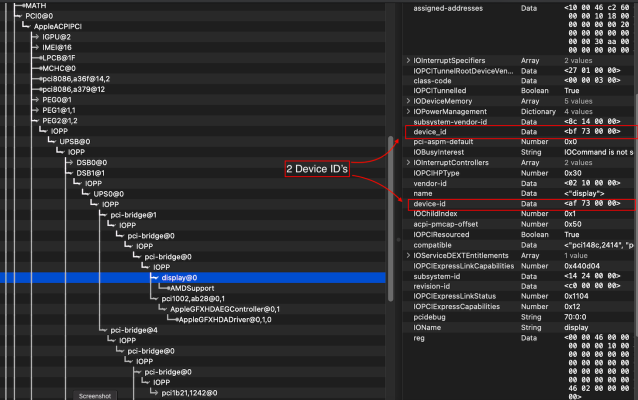@CaseySJ,
@tedyun did a good job summing everything up, but to clarify: I've been able to add the "model" & when I had the typo: "device
_id" in DeviceProperties, it successfully added it. However, when the typo was corrected, it failed to overwrite the device
-id.
The display plugged into the eGPU receives a signal for a brief moment during boot... Interestingly enough, if I shorten the device path to PEG2, UPSB, DSB1, or USP0 (the path for eGFX prior to the 3 pci-bridges), it is able overwrite the respective device-id... sounds like the issue has to do with the three pci-bridges:
I tried
@Gigamaxx's SSDT, but to no avail. I installed the debug version of WEG & Lilu added the debug boot-args for both to try to figure it out... can't find any logs though.
Under the 3rd pci-bridge is eGFX & "pci1002,ab28@0,1." The latter is HDMI audio for the eGPU and it's loaded... the 6800, 6800 XT, 6900 XT all share the same device-id & subdevice-id for HDMI audio hence why that's working. Is it possible the SSDT is failing to rename that 3rd pci-bridge (hence the failure to overwrite the device-id) because it's shared between loaded HDMI audio component and eGFX?
I've been on the latest version (v1.5.4) from the beginning. However, at one point, I did try v1.5.2 as v1.5.3 added:
- Added no-gfx-spoof to avoid forcing device-id values from PCI I/O.
Nothing else in the release notes for v1.5.3 & v1.5.4 applied to me and v1.5.2 "added device-id spoofing support for AMD graphics." Should I go back to troubleshooting with v1.5.2 (keeping the current version of Lilu of course)?
Here's my IOReg with your SSDT as well as my config.plist... I'm currently on Lilu v1.5.6 & WEG v1.5.4.

